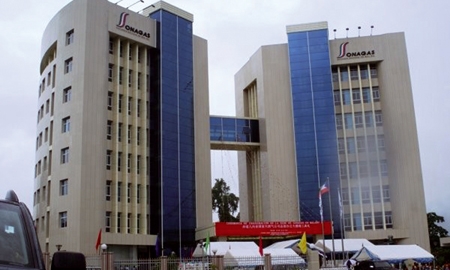Flowing from the Gulf of Guinea is a stream of crude so significant that in just a few short years it has transformed Equatorial Guinea from an agricultural backwater into one of sub-Saharan Africa’s largest oil exporters with a GDP per capita higher than many European countries. Production has increased from just 5,000 barrels per day (bpd) in 1995 (exploration began in the country in 1992) to 435,000 bpd in 2010, contributing to an average economic growth of 30% per year. The country today produces more barrels of petroleum per capita than Saudi Arabia, and oil generates 85% of the country’s GDP and 95% of government revenues.
“SONAGAS is fulfilling its mission to strengthen our industrial capacity through the training of skilled professionals. the company has also made satisfactory progress in LNG projects, in methanol, 3G, as well as the domestic gas project.” Gabriel Mbega Obiang Lima,
Deputy Minister of Mines, Industry, and Energy |
The majority of this oil comes from three main fields: Ceiba, Zafiro and Alba – all of which are located offshore in the Gulf of Guinea. According to Oil and Gas Journal, Equatorial Guinea had proven oil reserves of 1.1 million barrels as of January 2011 (representing 4.3% of global reserves), and to date, the 17 companies operating in the sector have invested over $40 billion.
Former Minister of Mines, Industry and Energy and current Minister of Finance and Budgets Marcelino Owono Edu comments: “With the entrance of the petroleum sector in the national economy, the economic trends of our country took on another dimension. Today, petroleum is the most important sector in the entire economy, and consequently, the engine of economic and social development in our country.”
Natural gas is also beginning to represent a sizeable economic force in the country, nearly “equal to the petroleum sector,” adds the Minister. While flaring was a common occurrence in the early years of the petroleum industry’s development, he says that the gas flow has now been harnessed, thanks to the government’s gas monetization policy, which funded the development of the nascent gas industry in the country.
“We began to establish industries like LNG, methanol, domestic gas and other uses and managed to significantly reduce the flaring that was being produced while adding value to our economy. Today, we are significant LNG producers and we export methanol to various countries around the world. We are also planning new industrial projects in petrochemicals with the aim of converting Equatorial Guinea into a global player with respect to this natural resource,” states Mr. Owono Edu.
Indeed, companies operating in the sector such as
EG LNG, Atlantic Methanol and
Marathon Oil are currently of building a world-class gas processing hub in the country, and Punta Europa on Bioko Island is now a major transshipment center for the industry. A consortium comprised of
Marathon Oil (60%), national gas company Sonagas (25%), and Mitsui and Marubeni (with 8.5 and 6.5% respectively),
EG LNG manages one of the most advanced gas processing facilities in the world, with capacity for processing 650 million cubic feet per day – the majority of which is obtained at the country’s Alba field. The facility boasts the only suspension bridge in the global LNG industry.
While the government has stated its intention to place a 300,000 bpd limit on oil production, at current production levels Equatorial Guinea has guaranteed petroleum reserves until 2035, and sufficient gas reserves for at least a decade longer. These could expand given the high possibility of future discoveries, especially with new exploration at Corisco Island near the border with Gabon.

0 COMMENTS